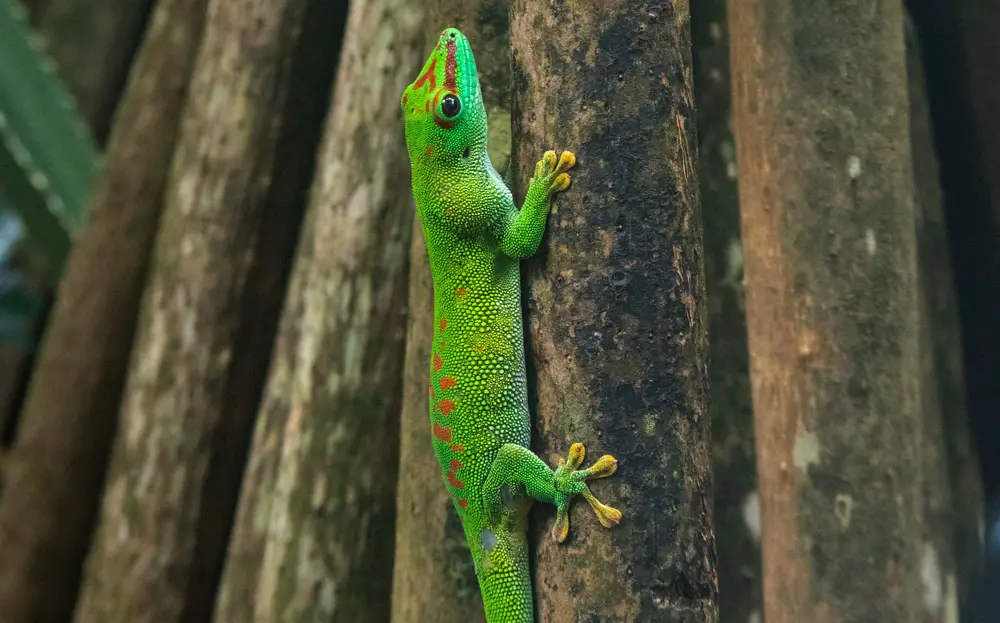Geckos are incredibly fascinating creatures and are commonly observed clinging to surfaces or scuttling across ceilings. Their genetic qualities are undoubtedly unique, and their feet’ design and structure play a large role in their abilities. So, why do geckos have sticky feet?
Geckos have sticky feet that can attach to and detach from various surfaces as needed, allowing them to traverse different surfaces easily. This ability is due to the presence of unique toe pads, setae, and microscopic spatulae, which work cohesively to create electrostatic magnetism to surfaces.
The adhesiveness of these little reptiles’ feet is extremely important to their lifestyles. While one may presume geckos have sticky feet overall, there is much more to it than meets the eye. Join us as we discuss how and why geckos have sticky feet and how they use this inherent attribute throughout their daily lives.
Do Geckos Have Sticky Feet?

Most geckos have feet that can stick to even the smoothest of surfaces, seemingly defying the observed laws of physics and gravity. They can stick to various surfaces and unstick their feet as they please without losing momentum, energy, or speed. But, how their feet flaunt a sticky behavior is not as straightforward as many may believe, and methods, in fact, predominantly rely on physics.
There are approximately 1,450 different species of geckos across the world, all of which have feet differing in size, shape, and color. But, the common genetic trait amongst most gecko species is the presence of minuscule forces between molecules, attributed to the countless components on the feet.
Feet Shape and Design
The adhesive nature of geckos’ feet is predominantly caused by the shape of the feet and additional structures, not the material or matter it’s comprised of. Upon closer inspection, geckos have feet that flaunt unique toe pads, identified by the lines underneath the toes. These lines reveal tiny skin flaps, which are imperative to its stick-on functionality.
Geckos’ feet are covered in microscopic hair-like structures known as setae which are approximately 100 microns in length, around the same width as a human hair. These structures branch off into hundreds of even smaller spatula-shaped structures known as spatulae, which are settled upon the tips.
These tiny structures are around 200 nanometers in length, smaller than a wavelength of visible light. Said structures comprise beta-keratin, similarly to feathers and scales, and are incredibly important for the functionality and adhesiveness of geckos’ feet.
Molecular Interactions and Forces
Since the structure and the surfaces both have electrons spinning, moderate attachment is scientifically plausible. Besides the general design and makeup of the setae and tips, these components’ specific angles and flexibility play a role in their attachment capacity in a range of loading conditions and how much suction will be created with any given surface.
What makes the gecko’s feet uniquely adhesive is that these tiny structures can interact with surfaces on a molecular level and have a sticky interaction due to weak forces known as van der Waals forces. The van der Waals forces can be summarized as the weak electrostatic magnetism amongst adjacent atoms or molecules that result from oscillations in the positioning of their electrons.
While it may seem to be an insignificant amount of force when evaluating what is generated by a single seta, numerous setae are scattered across a gecko’s feet. If calculated in unison, the summative force generated by these accumulated structures creates an incredibly strong and practical suction-like attachment to various surfaces. This molecular force is key for the gecko’s ability to stick to surfaces, even those that are smooth and slippery.
During the late 1990s, scientists uncovered these molecular forces that geckos’ feet utilize, but many of the research conductions were based on the common blue and orange Tokay gecko. Further research is being conducted, as there is still plenty of mystery surrounding the gecko’s biological capacities and the extent to which different gecko species have evolved over the past few million years.
Species Variations
Since there are so many different gecko species, there is plenty of room for diversity concerning functionality and capabilities. There may be variances concerning the shape and size of the gecko’s feet since different species have varying characteristics, including pad arrangements, flaps, hairs, and tips.
These natural characteristics afford varying levels of adhesiveness since stickiness is dependent on the feet’ structure and design. However, in most cases, the design of the feet is not necessarily superior to other species but is suited for a specific natural habitat and would be most useful for a gecko living within various surroundings.
Toe pad arrangements and design of structures and tips differ in length and shape but reveal various pertinent information concerning their natural habitats and evolutionary paths. Some structures are more suitable for gecko species living in trees, while others would be advantageous for gecko species living amidst artificial architecture in modern times.
Do Geckos Always Have Sticky Feet?
No, geckos do not always have sticky feet. While tiny genetically attributed structures are vital for their sticky interactions, it is also responsible for the practicality of having sticky feet. All of the tiny and microscopic structures work together harmoniously, utilizing molecular forces and laws of physics in unison.
Having constantly sticky feet may seem problematic, and it likely would be for these little creatures. Thankfully, the stickiness of their feet is only active when they are attached to a surface where additional grip is demanded. The flaps, hairs, and tips work cohesively to attach to surfaces and release from them swiftly, without harm to the gecko or the surface in question.
Attaching and Detaching from Surfaces
For a gecko to become latched to a wall, it would only take a minuscule angled force which would push the setae into their adhesive or suction cup position. To deactivate the stickiness and detach from the surface, the gecko would simply return the setae to a neutral position. Thus, geckos only activate the molecular workings of their feet’ components when it is necessary.
When are Sticky Feet Needed?
In a study conducted by Anthony Russell of the University of Calgary and Timothy Highan of Clemson University, it was found that geckos may not utilize any sticky attributes when running along a flat surface irrespective of the material. It seems that the friction of varying surfaces does not necessarily require stickiness for grip but rather the application of gravity and physics by the animal.
Geckos are more likely to utilize their sticky feet when traversing along surfaces at more than 10 – 30 degrees incline. That being said, friction may play a role in whether or not sticky feet are demanded since the molecular attractions involve intimate contact with microscopic bumps and indents within the surface being traversed.
However, these specifics will likely differ between different species, as every species flaunts distinct feet structures. Some species would be able to handle surfaces with more or less grip, while others may be able to scurry across higher inclines with little effort or demanded additional attachment.
Do All Geckos Have Sticky Feet?
Contrary to popular belief, not every gecko species can utilize sticky feet in the same manner. Of the approximate 1,450 gecko species worldwide, around 40% of these gecko species have non-stick feet. Some geckos do not have feet or even legs. Gecko species have evolved parallel to their habitat’s living conditions, and some have not developed sticky feet at all.
Why Did Geckos Develop Sticky Feet?
The historical lineage of various gecko species dates as far back as 200 million years, making many gecko species older than the dinosaurs. Throughout history, geckos have adapted countless times, evolving various aspects of their genetic makeup to survive in an ever-changing world.
Originally, geckos developed sticky feet to travel effortlessly within trees, across rocks, and amongst other organic surfaces within their natural habitats. These surfaces were the most common millions of years ago, without human intervention concerning structures and buildings.
In recent years, the availability of natural habitats and organic matter has become less prevalent, as most trees and natural structures have been replaced with human-made architecture and objects. Geckos adapted their sticky feet to traverse these surfaces as well and now commonly use their skills to scurry along walls and even ceilings.
What Do Geckos Use Their Sticky Feet For?
Geckos developed adhesive feet to move and traverse along as many different surfaces as possible, whether to find food, locate shelter, or flee and hide from predators. The ability to stick to surfaces and detach from surfaces at will is incredibly advantageous to geckos, as is their ability to reach places that may be hard to locate for predators.
The way in which the setae works to create a suction-cup effect on surfaces is also imperative to functionality and mobility for geckos. Due to the molecular forces being utilized, the setae across geckos’ feet can support approximately 50 times the gecko’s body weight, even when hanging from ceilings.
Setae’s complexity can generate millions of contact points between the gecko’s feet and the surface it’s traversing. Simultaneously, the functionality of setae doesn’t inhibit movement, and geckos can still run along surfaces at speeds of approximately 20 body length distances per second.
Geckos’ feet are incredibly alluring and mysterious for researchers and scientists and offer plenty of valuable knowledge for potential human-made creations. Insight into their genetic design and evolutionary paths opens a world of possibilities for artificial adhesives, wall-climbing robots, space-age adhesive materials, and other innovative technologies.
Sources

